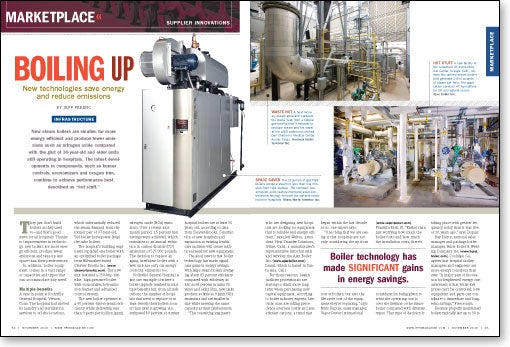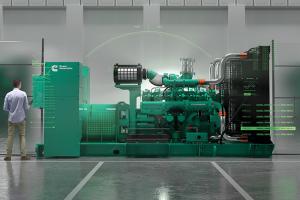Boiling up

New steam boilers are smaller, far more energy efficient and produce fewer emissions such as nitrogen oxide compared with the glut of 30-year-old and older units still operating in hospitals. The latest developments in components, such as burner controls, economizers and oxygen trim, combine to achieve performance best described as "hot stuff."
They just don't build boilers as they used to—and that's good news for all hospitals. Thanks to improvements in technology, new boilers are more energy efficient, produce fewer emissions and take up less space than their predecessors.
In addition, boiler equipment comes in a vast range of capacities and types that can accommodate any need.
Multiple benefits
A case in point is Rockville General Hospital, Vernon, Conn. The hospital had moved its laundry and sterilization services to off-site locations, which substantially reduced the steam demand from the former pair of 37-year-old, 500-boiler horsepower (bhp) fire-tube boilers.
The hospital's building engineers replaced one boiler with an optimized boiler package from Milwaukee-based Cleaver-Brooks Inc. (www.cleaver-brooks.com). The new unit featured a 250-bhp fire-tube, high-pressure boiler with economizer, low-emission burner and advanced control system.
The new boiler operates at a 90 percent fuel-to-steam efficiency while delivering less than 9 parts per million (ppm) nitrogen oxide (NOx) emissions. Over a recent four-month period, 15 percent fuel savings were achieved, which translates to an annual reduction in carbon dioxide (CO2) emissions of 527,000 pounds. The decision to replace an aging, inefficient boiler with a new unit not only cut energy costs but emissions too.
Rockville General Hospital is just one example of where a boiler upgrade resulted in multiple benefits but, from all indications, the number of hospitals that need to replace or at least retrofit their boilers sooner than later is growing. An estimated 80 percent of current hospital boilers are at least 30 years old, according to data from Cleaver-Brooks. Construction of new hospitals and expansion at existing health care facilities will create additional need for new equipment.
The good news is that boiler technology has made significant gains in energy savings, with large steam boilers averaging about 83 percent efficiency compared with efficiency as low as 60 percent in units 30 years and older. Plus, new units produce as little as 9 ppm NOx emissions and are smaller in size while meeting the same capacity as their predecessors.
"The consulting engineers who are designing new hospitals are looking for equipment that is reliable and energy efficient," says Jeff Welton, president, Heat Transfer Solutions, Irvine, Calif., a manufacturer's representative firm that sells and services the Ajax Boiler Inc. (www.ajaxboiler.com) brand, which is based in Santa Ana, Calif.
For those reasons, health facilities professionals are starting to think more long term when purchasing new capital equipment, according to boiler industry experts. Life-cycle costs are taking precedence over less costly and less efficient options, a trend that began within the last decade or so, one expert says.
"One thing that we are seeing is that hospitals are not only considering the up-front cost of boilers, but also the life-cycle cost of the equipment they're replacing," says Marc Dupuis, sales manager, Vapor Power International (www.vaporpower.com), Franklin Park, Ill. "Rather than just worrying how much the boiler costs and how much the installation costs, there's consideration being given to what the operating cost is over the lifetime of the future boiler compared with different types. That type of decision is taking place with greater frequency today than it was five or 10 years ago," says Dupuis.
Ray Pierce, national sales manager and package boiler manager, Hurst Boiler & Welding Company Inc. (www.hurstboiler.com ), Coolidge, Ga., agrees that hospital facility managers and engineers are more energy conscious than ever. "A major part of the reason for heightened energy cost awareness is that while fuel prices can't be controlled, new equipment and parts can contribute to immediate and long-term savings," Pierce says.
Because properly maintained boilers typically last up to 30 to 40 years or more, the additional 10 percent to 20 percent cost for units with the latest energy-saving technology is a smart investment that will pay for itself many times over, he says.
Replacing boilers with new, more efficient equipment also enables hospitals to correct over-capacity design flaws that were common decades ago as a safeguard against equipment and power failure. New boilers can allow hospitals to scale back what they need for steam generation.
"Hospitals are finding out they may not need three 500-bhp boilers," Pierce says. "Thirty years ago, when engineers designed systems, they thought they needed that many boilers. But in practice they didn't need that many, so they were inefficient from the outset.
"Through the learning curve and through greater efficiencies in building design, hospitals can install smaller boilers. New boilers are from 10 percent to 20 percent more efficient than they were 30 years ago."
Lots of options
When it comes to new boilers and the configuration of equipment, there is an abundance of options to fit any size health care facility and its needs. Because of the demand for steam for a variety of critical functions ranging from space heat to sterilization to kitchen and laundry services to producing hot water, traditional high-pressure water- or fire-tube steam boilers are still common.
Bill Bloom, national sales manager, Burnham Commercial (www.burnhamcommercial.com), Lancaster, Pa., says while most hospitals still gravitate toward the use of high-pressure steam units, any comparison with previous generations of the same boilers ends there due to advancements in technology. New units enable hospitals to save energy and cut emissions.
"More and more hospitals are becoming low NOx-emission conscious either through mandated requirements or just from trying to do the right thing. We've seen quite a few hospital installations that did not require low NOx-emission units, but they opted for it because it was the right thing to do. New boilers can reduce NOx emissions by up to two-thirds and more," says Bloom.
Bloom explains that low emission is possible because of improvements in the combustion process, controls and fuel burners. A process known as flue-gas recirculation recycles some of the stack gases through the burner, which helps reduce emissions too, he adds. Even new burner technology is incorporating revolutionary head designs that eliminate flue-gas recirculation and reduce NOx emissions even more.
Modular systems that comprise multiple smaller boilers offer an option for replacing old, larger conventional boiler equipment, especially backup units that frequently are required at hospitals. Jason P. Smith, LEED AP, energy and environmental specialist, Miura North America Inc. (www.miuraboiler.com), Atlanta, says modular systems offer advantages over conventional large-volume boiler systems.
"Modularity means rather than having very large capacity single units you break up your capacity into smaller modules," says Smith. "So if you need a 1,000-bhp boiler for a large hospital facility to meet its load rather than having two 1,000-bhp big tanks — one primary, one backup — you can break the energy output into modules of 100- or 200-bhp units that are controlled through a computerized control system to manage energy consumption to within tight tolerances.
"Modular systems will stage their multiple boilers on and off in a sequence that actually follows a hospital's specific load profile. Large percentages of overall capacity can be turned completely off in those cases in which you wouldn't need them," adds Smith. "In fact, the backup can be completely shut off at all times and then turned on if and when you need."
In effect, modular boiler systems provide on-demand thermal energy to hospitals and help mitigate the energy management challenges hospitals face in complying with code.
Condensing boilers that operate up to 95 percent efficiency frequently are used to produce hot water, but they are being used in a type of hybrid setup at St. Mary's Janesville (Wis.) Hospital to produce space heat. Earle Pfefferkorn, president, Cleaver-Brooks Package Boilers, says the high-efficiency condensing units will be combined with near-condensing boilers that operate at about 86 percent efficiency. Together they can handle any outside temperature load.
"Since we're in Wisconsin and we have very cold winters, near-condensing boilers don't run at high efficiency unless you have a large optimized system or you have moderate temperatures," says Pfefferkorn. "So we put in near-condensing hot water boilers to go with condensing hot water boilers.
"In the cold winter months when it's subzero outside, the near-condensing boilers with 86 percent efficiency will be running; and then in the spring and summer months, the condensing boilers run," adds Pfefferkorn. "So it's a hybrid system based on outside temperature and outside load that should get their heating system in the 91- or 92- percent efficiency range."
Instead of installing three large boilers in the 600-bhp to 800-bhp range, Cleaver-Brooks installed six smaller boilers. "We think this will be a focal point for a true hybrid boiler system," says Pfefferkorn, who calls the setup a "fairly dramatic departure from anything that's been done in the hospital industry before."
Quick startups are critical for backup boiler systems and large steam units can take 90 minutes to reach full power. To address the need for quick starts, Vapor Power International offers a compact design, low water-volume steam boiler that goes from cold start to full output in a few minutes.
"If our boiler is used as a critical standby unit, it can be setting cold for a day or week or a month and when that critical need comes, it starts up and in five minutes you've got full steam," says Dupuis.
Producing steam or hot water after capturing waste heat from a cogeneration system is yet another alternative, says Kevin Slepicka, senior sales engineer, Rentech Boiler Systems Inc. (www.rentechboilers.com), Abilene, Texas. The exhaust heat from a gas turbine that generates electricity is captured from the back of the turbine by a heat recovery steam generator.
New components
New, sophisticated components that drive boiler efficiency are common on new units today. With hospitals operating at razor-thin margins, retrofitting an existing boiler with new burners and other improved controls can make sense as long as the unit is otherwise operating properly, boiler experts say.
One such energy-saving component is the linkageless burner control system, also known as a parallel positioning system. The system maintains a precise mix of fuel and oxygen over a wide firing range to optimize combustion, which results in efficiency increases up to 3 percent.
Further efficiency gains up to 5 percent can be achieved through the use of new combustion controls and an excess air trim loop, or oxygen trim. The components have become common on new boilers and can be retrofit on existing ones as well, say industry experts.
Boilers 300 bhp or larger especially may benefit from installation of an oxygen trim control system because the control of excess air is increasingly important for units with a high-stack gas temperature, according to the Washington State University Cooperative Extension's Energy Program. An automatic oxygen trim control system minimizes operating costs by ensuring that the proper fuel-to-air mixture is maintained at all boiler loads.
An economizer is another common energy-saving component that works as a heat exchanger that captures the lost or waste heat from the boiler's hot stack gas. The economizer typically transfers this waste heat to the boiler's feed-water or return-water circuit, but it also can be used to heat domestic water or other process fluids.
Capturing this normally lost heat reduces the overall fuel requirements for the boiler, thus cutting fuel costs and emissions.
Jeff Ferenc is senior editor for Health Facilities Management magazine.
| Sidebar - For more information |
| For information on the boilers discussed in this month's "Marketplace," readers can contact the following manufacturers: Ajax Boiler Inc. Burnham Commercial Cleaver-Brooks Inc. Hurst Boiler & Welding Company Inc. Miura North America Inc. Rentech Boiler Systems Inc. Vapor Power International |




